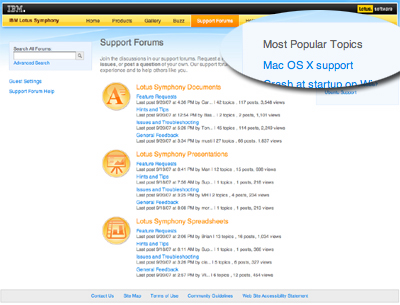 Do you remember Lotus Symphony?
Do you remember Lotus Symphony?
I sure do. It was originally introduced as the first Lotus integrated application to compete with AppleWorks (ahhh those were the days) but run on DOS. The concept of the all-in-one would extend their leadership in the spreadsheet market (Lotus 1-2-3) into adjacent applications markets. I was working as an engineer where one of my responsibilities included preparing the financial modeling for capital equipment purchases. I used Symphony to automate the calculations and print the reports. It was a pretty neat scripting mechanism. My boss used it to develop a financial forecasting model to game the production bonus system.
In New York City this past week, at the Lotus Collaboration Summit Michael Rhodin announced Lotus Symphony was coming back as a free (telephone support costs extra) suite of three Windows-based editors for word processing, spreadsheets and presentations. The integrated suite supports all the appropriate document formats (especially Microsoft Office formats) and the Open Document Format (ODF).
So, now we have Sun with the StarOffice, Google with GoogleApps and now IBM with Lotus Symphony all gunning for market share with Microsoft Office. This should be good for users. Particularly organizations with casual or simple needs for word processing, spreadsheets and presentation software. Here's the Wall Street Journal story.
I remember the constant file format changes and the constant new features or new user activation processes for Microsoft PowerPoint, Word and even Excel. I remember joking in frustration – how many more features can you stuff into a word processor?
 What does this mean in the market?
What does this mean in the market?
Well, first of all, the most frequent selection in the support forum was a request for Apple OS X support. Some provided an anecdote about their frustration level with using Microsoft Office on the Mac OS.
The personal productivity software market is not as mature as you'd think. This is an excellent step towards establishing a competitive balance in this market. It's going to be interesting to see what market segments adopt the implementation.
Surely, this functionality is more attractive to some industries as opposed to others. Maybe education? government? defense? software industry? Many of these companies see the world becoming more heterogeneous and forcing Microsoft into the great feature simplification.
What should Microsoft do?
See the Take Action Memo.






